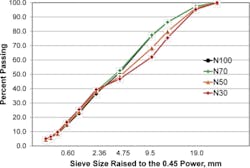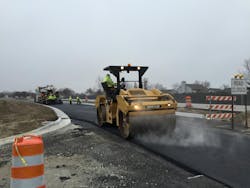By: Rebecca McDaniel, P.E., Ph.D
Durability issues are a leading cause of asphalt pavement deterioration and eventual failure.
Aggregate quality standards and mix design requirements have helped to resolve rutting issues, and performance-graded binders and binder selection guidelines have made major inroads in controlling thermal cracking. But over the long term in service, asphalt mixtures oxidize, become more brittle and start to suffer the effects of exposure to the elements. Durability-related problems manifest themselves most commonly in cracking and raveling.
There are various approaches that states have taken to improve the durability of asphalt pavements at the mix design stage. Some agencies have established minimum binder contents, while others have reduced design air void levels. A new approach being explored in Indiana goes the opposite way—increasing the design air void content—along with increasing the field density. The approach, called Superpave5, is modeled after the French approach to mix design.
The premise of success
Under Superpave5, mixtures are designed at 5% air voids, instead of the usual 4%. The major difference, however, is that these mixtures are intended to be compacted to the same 5% air void level in the field. Typically, mixes are compacted to 7-8% air voids and traffic is expected to compact the mixes further to around 4% at the end of the service life. Reducing the number of design gyrations (Ndes) in the gyratory compactor is an essential change, as this helps to make the mixtures more compactable by allowing for changes in the aggregate structure. The theory behind Superpave5 is that by achieving a higher density in the field at the time of construction, further densification under traffic will not occur and the mix will not rut.
Another key feature of Superpave5 is that the effective asphalt content is the same as for a mix designed at 4% air voids—this can be achieved by increasing the design voids in the mineral aggregate (VMA) requirement. It is the combination of lower air voids in the pavement with adequate effective binder in the mix that should improve the durability of the mixture. In theory, increased field density will reduce the permeability of the pavement, which in turn will reduce age hardening in the binder and extend the service life of the pavement.
This mix design concept was explored through research conducted at Purdue University and the North Central Superpave Center, under the sponsorship of the Indiana Department of Transportation (INDOT) and the collaboration of the Heritage Research Group. The research was initially intended to be a laboratory study, but promising lab results led INDOT to construct field trials as well. The objective of the research was to investigate potential changes to mix design compaction to promote increasing in-place durability without sacrificing rutting resistance.
Figure 1. Example of changes in gradation to achieve 5% air voids at varying gyration levels.
The approach taken in the laboratory phase of the project was to start with three conventional 4% mix designs (sometimes called Superpave4 mixes) and redesign them to achieve 5% air voids at various gyration levels with the same effective asphalt content. The three standard mixes were all designed at 100 gyrations for traffic levels between 3 and 30 million equivalent single axle loads (ESALs). Two of the mixes were 9.5-mm surface mixes, and the other was a 19-mm intermediate mix. The coarse aggregates consisted of limestone, dolomite and blast furnace slag, while the fine aggregates included limestone, dolomite and natural sand. A PG 64-22 binder was used in all of the mixes. No recycled materials were used at this stage of the research. These three standard mixes were then redesigned at 70, 50 and 30 gyrations using the same aggregates in different proportions, as shown in Table 1. The Bailey method was used to guide the changes in the aggregate gradation.
The results of the mix designs showed that no changes in the aggregate gradation were needed to achieve 5% air voids at 70 gyrations; in other words, decreasing the number of gyrations by 30 increased the air voids by 1%. The mixes designed at 50 and 30 gyrations, however, did require changes in the aggregate gradation, as shown in Figure 1. It was possible to design mixes at 5% air voids with the same effective asphalt content at the reduced gyration levels using the same materials. The question remained, however, whether these mixes would perform as well as the standard mixes. Would they be able to resist rutting as well as the original mixes?
After extensive laboratory testing and two successful field trials, the concept of designing and constructing asphalt mixtures at 5% air voids looks promising.
Testing
The mixes were therefore tested in the laboratory to determine their mechanical properties. The dynamic modulus and flow number tests were employed to assess the mixture stiffness and resistance to rutting. These tests were conducted on specimens compacted to the expected field density; that is, the standard Superpave4 mix specimens were compacted to 7% air voids and the Superpave5 mix specimens were compacted to 5% air voids. The test results indicated that, at the expected field density, the Superpave5 mixes had equivalent or better mechanical properties compared to the 4% mix designs. The Superpave5 mixes had consistently similar or higher modulus values and higher flow numbers, which would suggest that the mixes would perform at least as well as the standard mixes in terms of resistance to rutting. Their reduced field air voids would be expected to reduce oxidation and improve the durability of the pavement.
Based on these encouraging lab results, INDOT decided to allow construction of a pilot project on S.R. 13 in northern Indiana in 2013. The project was a 1.5-in. mill and fill on a two-lane road with turn lanes. The trial mix was a 9.5-mm mix with steel slag coarse aggregate, limestone and natural sand fine aggregates, a PG 70-22 binder and 7% recycled asphalt shingles (RAS), which yielded a 20.2% binder replacement ratio. The trial mix was initially designed at 30 gyrations but was changed in the field to 50 gyrations. Core densities showed that the average air void content for the Superpave5 mix was 5.3% and the Superpave4 mix was compacted to 8.2% air voids. The lower air void level was achieved without any changes in the number or types of rollers, nor in the rolling pattern.
To investigate whether the Superpave5 mix would indeed be more resistant to aging and the resulting durability problems, samples of the plant-produced mixes from the field trial were taken back to the lab for testing. They were tested for dynamic modulus, flow number and beam fatigue in their post-construction condition and after oven-aging to simulate roughly eight years of field aging (five days at 185°F). Binder was extracted and graded from the compacted plant-produced and aged mixtures as well, in order to explore whether the mixes aged differently at the different field air void contents.
In this case, the test results were not as clear, nor quite as favorable as in the laboratory phase. The Superpave5 mix had a lower dynamic modulus than the standard mix post-construction, but the mixes had similar moduli after aging. The Superpave5 mix also had a lower average flow number at the time of construction, but it endured more strain at flow number. After aging, the average flow numbers and strain at flow number were similar, with the Superpave5 mix having slightly higher values. The beam fatigue results were inconclusive due to high variability, as is often observed with fatigue testing. The recovered binder gradings were encouraging, however. The binder in the Superpave5 mix hardened less in compacted specimens during oven-aging.
Despite the somewhat inconclusive mix test results, INDOT was still interested in evaluating another field trial. The city of Indianapolis was willing to collaborate with INDOT and the research team and allowed a second test section to be placed on Georgetown Road on the northwest side of the city. This project was a total reconstruction and widening job. The trial mix was a 19-mm intermediate course placed at a lift thickness of 3 in. The original design was done with 100 gyrations and a design air void content of 4%. The mix was redesigned with 30 gyrations and 5% air voids. Both mixes used limestone coarse aggregate, dolomite sand, RAS and a PG 64-22 binder.
To make the field trial even more challenging, the intermediate mix was placed in December 2014 with temperatures ranging between 34-43°F over a light wind. Nonetheless, the contractor was able to achieve good densities; the Superpave5 mix was compacted to an average air void content of 4.8%, while the conventional mix was compacted to 6% air voids.
The results of lab testing of the plant-produced mixes and field cores showed that, as in the initial lab research, the redesigned mix had higher dynamic modulus values than the standard mix. Instead of performing beam fatigue testing, the research team used a semi-circular bending (SCB) test to assess the mixtures’ resistance to cracking. SCB results on field cores showed that the redesigned mix had slightly lower resistance to cracking than the standard mix at the time of construction, but was more resistant to cracking after oven-aging and changed less than the standard mix during aging. This suggests that the Superpave5 mix may be more resistant to aging, as theorized. Hamburg testing showed that both mixes were highly resistant to rutting. Binder grading on the extracted and recovered binders again showed that the binder in the Superpave5 mix hardened less during simulated aging.
Time will tell
After extensive laboratory testing and two successful field trials, the concept of designing and constructing asphalt mixtures at 5% air voids continues to look promising. Only time will tell whether the mixes do in fact have improved durability in the field without loss of rutting resistance. Therefore, the performance of these field trials will be monitored to establish how they perform compared to the conventional mixes. To date, no rutting has been observed in the standard or redesigned mixes. INDOT is currently planning to construct additional pilot projects at other traffic levels and with a wider range of materials to refine the design gyration levels.
The two field trials have demonstrated that relatively simple changes in the mix design process can produce mixes that are easier to compact in the field. Contractors were able to achieve the desired level of compaction without resorting to extreme measures, excessive numbers of passes or changes in the compaction equipment. This experience suggests that the Superpave5 mix design concept holds great promise for practical implementation and has the potential to significantly improve asphalt mixture durability. R&B
Thanks to Dr. John Haddock, Ali Hekmatfar, Ayesha Shah, Gerry Huber, Bill Pine and Milestone Contractors LLC for their participation in and assistance with this study. The support of the Indiana Department of Transportation and the Purdue University Joint Transportation Research Program is gratefully acknowledged.
About The Author: McDaniel is technical director of the North Central Superpave Center at Purdue University.






